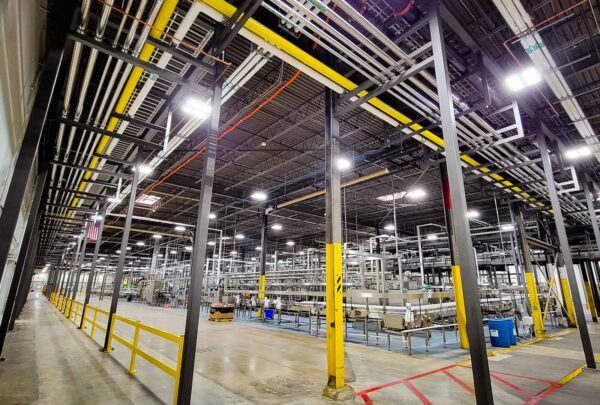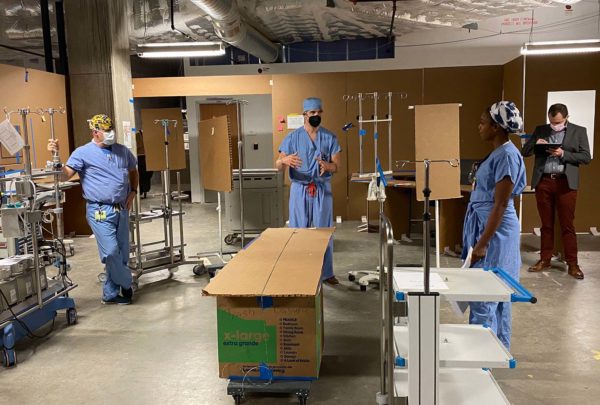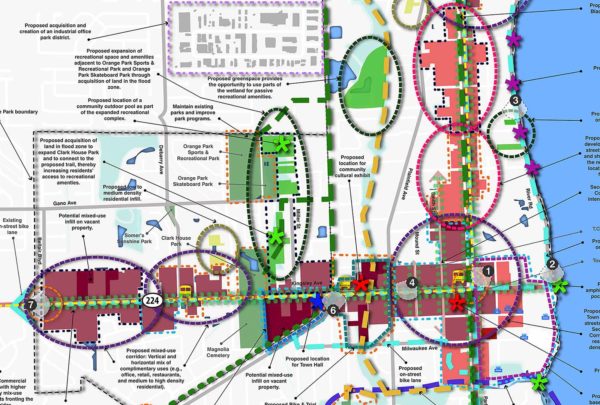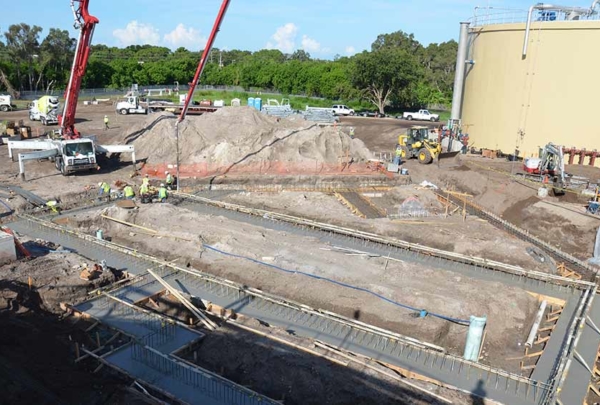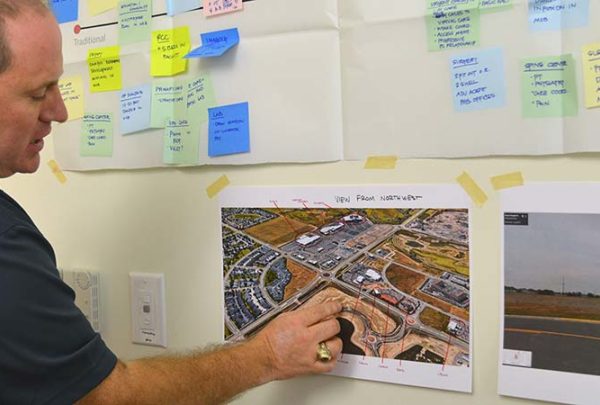Say you’re an architect designing a new building of Type I or Type II non-combustible construction. You submit your plans to the local building department, and at some point, the fire marshal or the building official asks, “Does the exterior wall assembly need to comply with NFPA 285?” If you can’t answer this question, you could be in for a rough go of it.
The Test
NFPA 285 is a test method for determining how combustible materials contribute to burning when included in non-combustible exterior walls. It is licensed by the National Fire Protection Association (NFPA). The full name of the test is “Standard Fire Test Method for Evaluation of Fire Propagation Characteristics of Exterior Wall Assemblies Containing Combustible Components.” It’s a burn test where a specific exterior wall assembly is set on fire for 35 minutes, then the flames are extinguished and careful measurements are taken to determine how far the fire spread.
It’s critical to understand this test is for an entire wall assembly, not a singular material within the wall. The assembly includes everything from the skin of the exterior face to the interior gypsum finish. Each material, how it is anchored and how often, its thickness, its density, spacing, edge conditions, and joint treatment are specifically described. Your design can’t vary in any way from the tested assembly. Like a UL assembly, it’s all or nothing. Say your design calls for foam insulation in the exterior wall. You do some research and find a tested assembly. Only the tested assembly’s skin is made with ceramic tiles manufactured in a boutique shop in Italy. For aesthetics, durability, and economy, you prefer bricks manufactured by Taylor Clay Products in Salisbury, North Carolina, in lieu of the Italian imports. Well, too bad. The assembly calls for the ceramic tiles. If you don’t use the tiles, you can’t use the assembly. Remember, it’s all or nothing when it comes to the assembly.
The test is described in a 27-page document you can purchase from the NFPA’s website. The document is broken into 11 chapters.
- Chapter 1: Administration
- Chapter 2: Referenced Publications
- Chapter 3: Definitions
- Chapter 4: Test Facility and Apparatus
- Chapter 5: Test Specimen
- Chapter 6: Instrumentation
- Chapter 7: Calibration Procedure
- Chapter 8: Fire Test Procedure
- Chapter 9: Data Collection and Observation
- Chapter 10: Conditions of Acceptance
- Chapter 11: Report
If you’re a detail geek like me, read the entire report to glean the weight of ceramic fiber blankets and the cubic meter flow rate of gas. If you’re a busy architect looking to pull only the applicable information, focus on Chapters 5 and 11.
Chapter 5 explains exactly how the test specimen must be designed and constructed. The product manufacturer provides this information to the testing lab. Much like a UL assembly, the materials in the test assembly cannot be varied. You can’t substitute manufacturers or thicknesses, nor can you add or delete things. NFPA 285 is an assembly test. If you vary the assembly, the test data is void. The critical thing to note in Chapter 5 is the closure at the head of the window opening. This is a critical part of the test assembly, and it’s where most assemblies fail. The closure at the window header must be described in the test data per section 5.7.3. And per paragraph 5.7.3.4, this information must be included in the final test report described in Chapter 11.
Chapter 11 is the test report. It is produced by the testing lab and given to the manufacturer. It describes the test specimen, all the data collected in the test, visual observations made during the test, and photographs documenting everything from the start of construction to the last ember going out. And as referenced in Chapter 5, the report must include detailed drawings and a written description of the window head. Paragraph 11.1.1.b describes exactly what must be included in the test report for the window head. Remember, most assemblies fail at the window head, so knowing how the head must be detailed in your construction documents is important. Get this test report from the manufacturer.
Does NFPA 285 Apply to My Building?
The graphic below is a simple way to determine whether NFPA 285 applies.
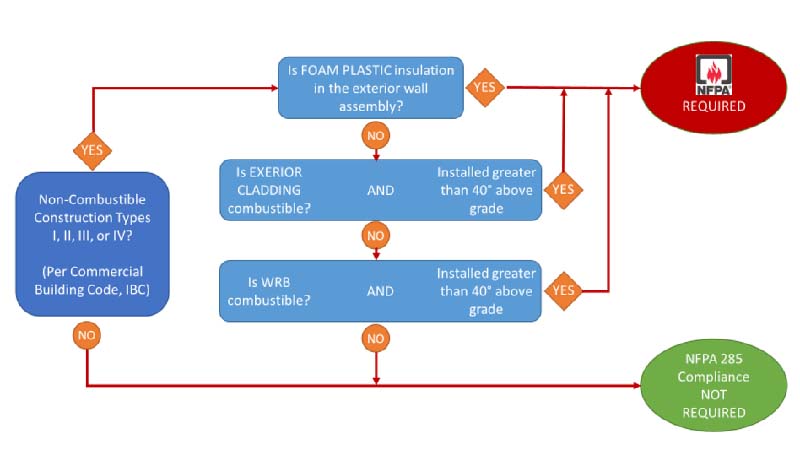
For further clarity, I recommend reviewing the following sections of the International Building Code (IBC) for reference to NFPA 285:
- 1403.5, Vertical and Lateral Flame Propagation (applicable to combustible weather barriers)
- 1407.10.4, Full-Scale Tests of Metal Composite Materials (metal panels, such as Alucobond)
- 1409.10.4, Full-Scale Tests of HPL (high-pressure laminates)
- 1510.6, Mechanical Equipment Screens (rooftop screens made of combustible materials)
- 2603.1, Foam Plastic Insulation
- 2603.5, Exterior Walls of Buildings of Any Height (foam insulation in non-combustible exterior walls)
- 2603.5.5, Vertical and Lateral Flame Propagation (applicable to foam insulation)
Summary
If you put combustible material into the exterior wall assembly of Type I or Type II non-combustible construction, you will need an exterior wall assembly compliant with NFPA 285. Combustible materials include foam insulation, combustible weather barriers, wood, metal composite materials such as Alucobond, high-pressure laminates, and everything else that is “combustible.” If you’re not sure whether a material is combustible, ask the manufacturer.
If you have combustible material and must comply with NFPA 285, you will need to find a tested assembly. You’ll need to understand everything about that assembly, so make sure you get the test report. Don’t settle for catalog cut sheets, marketing material, or a product data summary. Ask for the actual test report and make sure it includes the window head information per 11.1.1.b.
To learn more about NFPA 285 testing, check out my blog “The Loophole in NFPA 285.”


